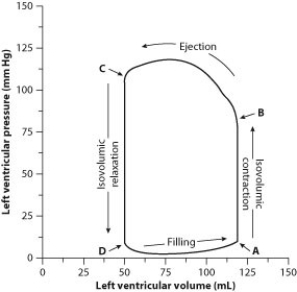To evaluate cardiac function, scientists and physicians measure both the pressure and the volume inside the heart. When both pressure and volume data are plotted on the same graph, the resulting graph is called a pressure-volume loop. To create a pressure-volume loop, a catheter (a thin tube) is inserted into the vessels of the heart, and measurements of both left ventricular pressure and left ventricular volume are taken. The data are plotted on a graph, and cardiac function can then be evaluated from the distribution of the data and the shape of the loop.
The following figure shows a typical left ventricle pressure-volume loop for a healthy young adult. The cardiac cycle proceeds counterclockwise. Each complete turn around the loop (for example, starting at point A and ending back at point A) represents one complete cardiac cycle.

-Aortic stenosis is a disease in which the aortic valve (the semilunar valve between the left ventricle and the aorta) narrows, resulting in increased left ventricular pressure and reduced ejection volume (the amount of blood that the left ventricle ejects) . What would the pressure-volume graph for a patient with aortic stenosis look like compared to the graph shown above for a healthy young adult?
Definitions:
Higher Levels
A term indicating advanced stages or degrees of complexity, often used in reference to education, management, or organizational structure.
Management
The process of coordinating and overseeing the work activities of others to achieve organizational goals efficiently and effectively.
Direct Expense
Costs that can be directly attributed to the production of specific goods or services, such as raw materials and labor.
Sporting Goods Department
A specialized division within a retail store or company focused on the sale and distribution of sports and fitness equipment.
Q19: In the equation 2 H<sub>2</sub> + O<sub>2</sub>
Q23: Plants have specific temperatures (or temperature ranges)
Q23: _ spend almost all of their time
Q31: One of the functions of skin is
Q36: Which of the following types of cells
Q38: You are taking someone's blood pressure and
Q38: A mutation in the gene for hormone
Q38: Cilantro tastes soapy to some people because<br>A)
Q48: Which line on the graph corresponds to
Q66: After you swallow the first bite of